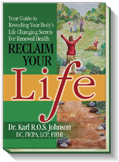Tendonitis in any area of the body can be quite painful and debilitating, often interfering with your daily lifestyle.
I often see patients who have tendonitis and the challenge is to help the patient understand the various steps and procedures that need to be undertaken in the healing of this type of injury. Of course there are many different places in the body a tendon can be injured but the wrist, knee, and achilles tendons are the most common ones I have seen. In this blog post I outline a few aspects about tendon construction, tendon healing, and natural methods (drug-free, surgery-free) that I and others have found to be helpful and effective to enable patients to get back to their normal lifestyle.
Tendonitis refers to inflammation of a tendon, which is the tough rope-like tissue that attaches muscles to bones. Tendons vary in form, and can be rounded cords, strap- like bands or flattened ribbons. [1]
Overuse, injury, and various systemic inflammatory conditions of the body can cause tendonitis. Some medical researchers state that the term tendonitis should be reserved for use only after performing a biopsy and then examining the tissue under a microscope and instead, the term tendonopathy should be used until a biopsy is performed. Regardless of the term used, a good understanding of how to best approach a tendon injury is important.




